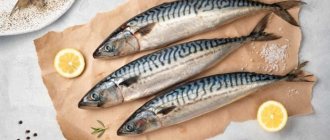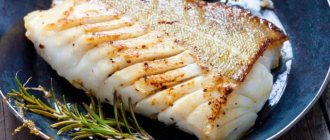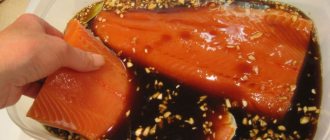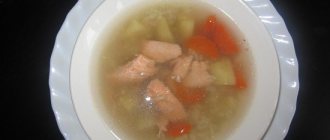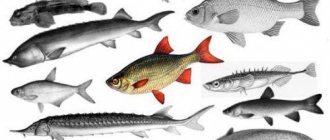Mackerel is a well-known and beloved fish that every person has tried. But few people thought that it could be different. Often stores sell both Pacific and Atlantic. On the shelves of our stores there are carcasses of different sizes, but this does not mean that the larger one is fattier and larger. These are just two different fish - mackerel and mackerel, although they are related. They are very similar in appearance, but if you look closely and take a closer look, you can see that they are completely different, even their taste is different.
mackerel
Origin of the species and description

Photo: Mackerel
The ancestors of fish appeared a very long time ago - over 500 million years ago. The very first reliably established one is a pikaya, a creature 2-3 centimeters in size, looking more like a worm than a fish. Pikaia had no fins, and it swam by bending its body. And only after a long evolution the first species resembling modern ones appeared.
This happened at the beginning of the Triassic period, at which time the class of ray-fins, to which mackerel belongs, arose. Although the most ancient ray-finned animals are also very different from modern ones, the basics of their biology remain the same. And yet, the ray-finned fish of the Mesozoic era almost all became extinct, and those species that inhabit the planet now arose already in the Paleogene era.
Video: Mackerel
After the extinction that occurred at the border of the Mesozoic and Paleozoic, about 66 million years ago, the evolution of fish went much faster - like many other orders. Speciation became much more active, because it was fish that began to dominate in water bodies, suffering less from extinction than other aquatic animals. It was then, at the very beginning of the new era, that the first representatives of the mackerel family appeared: the then extinct Landanichthys and Sphyraenodus, as well as the bonito genus, which has survived to this day. The oldest finds of these fish date back more than 65 million years.
The mackerels themselves appeared somewhat later, by the beginning of the Eocene, that is, approximately 55 million years ago, at the same time, most of the other genera belonging to the mackerel family were formed, and its real flourishing began, which continues to this day. The period of most active speciation ended precisely then, but individual species and even genera continued to appear in subsequent eras.
The genus mackerel was described by C. Linnaeus in 1758 and received the name Scomber. It is noteworthy that the family to which it belongs (mackerelidae) and even the order (mackerelidae) were named after this fish. From a systematic point of view, this is not entirely true, because mackerels were not the first to arise even in the family, but this genus is the most famous.
Appearance and features

Photo: What mackerel looks like
The average length of this fish is 30-40 cm, maximum 58-63 cm. The average weight of an adult is 1-1.5 kg. Its body is elongated, spindle-shaped. The snout is pointed. It is most easily recognized by the characteristic dark stripes on the back, despite the fact that the belly does not have them - the transition from a striped color to a monochromatic color in the middle of the fish’s body is very sharp.
The back of the mackerel is dark blue with a steely sheen, and the sides and belly are silver with a yellowish tint. As a result, when mackerel appears at the surface, it is difficult for birds to see it, because it blends in with the water in color; on the other hand, it is hardly noticeable to fish swimming below, since for them it merges with the color of the sky, as it is seen through the water column.
Mackerel has well-developed fins, and it has additional ones that allow it to swim faster and maneuver better. All species except the Atlantic have a swim bladder: in combination with a streamlined body and developed muscles, this allows it to swim at a higher speed than other species can reach, up to 80 km/h.
It reaches such speed in a sharp throw in just two seconds, which is comparable to the acceleration of the fastest cars, but it can also maintain it for a matter of seconds. Typically, all types of mackerel swim at a speed of 20-30 km/h, in this mode they can spend most of the day and not become exhausted - but for this they need to eat a lot.
The teeth of mackerel are small, they do not allow them to hunt large prey: it is very difficult to tear tissue with them, they can only gnaw through very weak scales and soft tissues of small fish.
Interesting fact: When a large school of mackerel rises to the very surface of the water, the movement of these fish causes a roar that can be heard even at a distance of more than a kilometer.
The most valuable varieties of red fish
The most popular salmon and some of the best fish delicacies are salmon and trout. They can be pickled, salted, fried, stewed and baked. Salmon has bright pink meat, trout has lighter flesh. This fish should be eaten at least 2 times a week, especially for women: salmon and trout help maintain healthy skin, nails, hair and, of course, stay beautiful longer.
Salmon or noble salmon
In addition to a high concentration of omega-3, salmon also has an ideal ratio of omega-3 and omega-6. Only two foods in nature can boast such a unique balance of these fatty acids - flaxseed and walnuts. Regular consumption of salmon is the prevention of thrombophlebitis, improved blood circulation and metabolism, normalization of the gastrointestinal tract and liver, strong arteries, strong immunity and a healthy nervous system.
Salmon is salted, smoked, fried in a frying pan in marinade and breading, and used to make pancakes, solyankas and other delicacies. But it’s better to bake this fish - in foil or on the grill, or eat it lightly salted. Noble salmon has unusually tender and very tasty meat.
Calorie content of salmon is from 140 to 220 kcal per 100 g. Fat content is from 6 to 24%, protein is approximately 20%.
Trout is not only tasty, but also a beautiful fish: with a golden belly, yellow-green sides with black dots sometimes surrounded by a blue border, an olive-green back and multi-colored spots on the fins. Trout is often called goldfish. There are several types: freshwater, rainbow and sea.
Like salmon, this red fish is a very valuable food product, as it is rich in fatty acids, vitamins and minerals. Trout goes well with lime, lemon and cream sauce. Even ancient cookbooks say that it is better to stew it in the oven with wine, vegetables and herbs or bake it in butter.
Trout calorie content is from 97 to 208 kcal per 100 g. Fat content is from 4 to 14%, protein is approximately 20%.
Contraindications to eating red fish
Trout and salmon should not be consumed by pregnant women or nursing mothers, as some species may contain mercury. People suffering from obesity and gastrointestinal disorders, especially stomach ulcers and chronic liver diseases, should not indulge in fatty fish. Without a doubt, those who are allergic to fish should also be careful.
Every person who cares about their health needs to include red fish in their diet. Just 300 g of this fish delicacy per week is enough to provide the body with the fatty acids necessary for its full functioning. The most useful types of red fish, besides salmon and trout, are chum salmon and pink salmon. From time immemorial, many peoples of the North ate pink salmon and were distinguished by amazing health.
Where does mackerel live?

Photo: Mackerel fish
Each species of this fish has its own range, although they partially overlap:
- Atlantic mackerel is found in the North Atlantic and is also found in the Mediterranean Sea. In warm times it can reach the White Sea, and most of all in the Northern Sea;
- African mackerel also lives in the Atlantic, but further south, their ranges overlap, starting from the Bay of Biscay. It can also be found in the Canary Islands and the southern half of the Black Sea. It is most common in the Mediterranean Sea, especially in its southern part. Juveniles are found as far as the Congo, but adults swim north;
- Japanese mackerel lives off the eastern coast of Asia and around Japan, the islands of Indonesia, to the east it can be found all the way to Hawaii;
- Australian mackerel is found off the coast of Australia, as well as New Guinea, the Philippines, Hainan and Taiwan, Japan, and is distributed as far north as the Kuril Islands. It can also be found far from its main habitat: in the Red Sea, the Gulf of Aden and the Persian Gulf. Although fishing for this species is also carried out, it is valued lower than the Japanese species.
As you can see, mackerel lives mainly in waters of moderate temperature: there are few of them and too far to the north, in the seas of the Arctic Ocean, and in too hot tropical ones. At the same time, the warmth of the waters of the seas in which it lives varies greatly. The point here is seasonal migrations: it moves to places where the water is at an optimal temperature (10-18 °C).
Only the fish inhabiting the Indian Ocean practically do not migrate: there the water temperature changes little throughout the year, and therefore there is no need for migrations. Some populations migrate over fairly long distances, for example, Black Sea mackerel swims to the North Atlantic in winter - thanks to warm currents, the water there remains in the optimal range. When spring comes, she makes the return journey.
Now you know where mackerel is found. Let's see what this fish eats.
In what form is it sold, how to choose
The following types of mackerel can be found in stores:
- Fresh. It is found only on the shelves of retail outlets located in places where this fish is caught. The reason is that mackerel can be stored for no more than 72 hours. Then it begins to deteriorate. When buying fish, you need to pay attention to its appearance and smell. Good mackerel has a light marine aroma, clear pupils, red gills, and an elastic body without dents or cuts. A stale carcass has dry skin, sunken eyes, and gray gills with a sticky coating.
- Fresh frozen. It occurs most often, since according to GOST the shelf life at temperatures below 18 degrees is from 2 to 8 months, depending on the type of fish. Atlantic mackerel can be kept frozen the longest. The freshness of the product must be determined by the thickness of the glaze and the appearance of the carcass. On good fish, there is a layer of ice up to 1 mm thick that does not peel off when tapped, and there are no red or rusty streaks. Carcasses should not be stuck together. If this is not the case, then the mackerel was re-frozen.
- Hanging. It is prepared by salting it in a marinade and then drying it. Stored in the refrigerator for no more than 3 days. When purchasing, you need to choose carcasses that do not have an unpleasant odor, blood or red streaks. The fish should have a shiny, slightly wrinkled skin.
- Smoked. Prepared using hot and cold methods. With the first method, the shelf life in the refrigerator should not exceed 3 days. With the second, the duration depends on the packaging. At temperatures from 0 to minus 4 in a vacuum, mackerel remains of high quality for up to 20 days, in cardboard packs - a week, opened without a vacuum - 10 days. Good carcasses have a uniform golden hue, intact skin, a light woody aroma, and dense meat. Vacuum packages must be free of moisture.
- Salty. There is a spicy salting and a regular one. Sold uncut and without head. Shelf life according to GOST depends on the amount of salt used and storage location. Without the head, lightly salted mackerel in a barrel remains of high quality for 5 months, medium salted mackerel for 6 months. Uncut fish can be stored for 1 month less. In plastic buckets it does not deteriorate for up to 90 days. When purchasing, you need to choose fish with shiny, moist skin, without foreign aromas or blood stains.
- Canned food. The most common types are natural mackerel in oil and pieces in tomato sauce. When purchasing, it is better to take a product made from unfrozen raw materials, produced on a floating vessel. You can recognize such a dish by the marking P08; if the number 13 is indicated, the fish was preserved on land. It is necessary to pay attention to the type of jar and the inscription on the label. You cannot take a product with a suitable expiration date, in a damaged or swollen jar, or made not in accordance with GOST. In addition to fish, it should not contain additives other than salt, spices, oil and tomato dressing.
- Kippers. It is a smoked, cut and spread out carcass. When purchasing, you need to choose small-sized mackerel, vacuum-packed. Such fish can be stored longer - up to 45 days, and the composition and date of manufacture are indicated on it.
Benefits of eating caviar
Mackerel with milk and caviar rarely hits the shelves. The reason is that the fish go far into the ocean or sea during spawning and are not caught. Caviar contains more iron than meat, so it quickly eliminates anemia. It also helps you lose weight, helps lower cholesterol levels, and speeds up the cell repair process.
Milk is less fatty, but rich in protein, which is absorbed faster than from fillet. The product also contains a lot of vitamin E, which is beneficial for the skin.
The liver contains a large percentage of omega-3 acids, but preparing it at home is difficult, since this organ is small in fish. The by-product is not used in cooking, but by producers of fish oil, which is sold in pharmacies as a dietary supplement.
Harm from smoked mackerel and canned food
Hot and cold smoked mackerel is a delicious appetizer or addition to a side dish of potatoes. The product is nutritious, delicate, and has a pleasant smell. However, eating such fish is harmful to health.
The reason is that during processing in the smokehouse, mackerel is saturated with carcinogens that provoke malignant tumors. The disadvantage of the product is also its high calorie content and salinity. Smoked fish can cause swelling and excess weight.
Canned food is sold under different brands. For example: “5 Seas”, “For the Motherland”, “Forward”, “Connoisseur”, “Leopard”, “Captain of Taste”, “Baltic Seine”, “Kuril Coast”, “Trawl Fleet”, “Fischerel”, “Goldfish” ", "Dobroflot", "Fish menu". Far Eastern natural mackerel with added oil is especially popular.
Manufacturers position the product as a healing and nutritious dish. However, only canned food made at home without adding chemical components that increase shelf life can be beneficial. Prepared foods in jars are harmful. Causes:
- If production rules are violated, bacteria can enter the packaging and cause poisoning.
- Preservatives that cause cancer and liver and kidney damage are often added to industrial products.
- During storage, fish may oxidize. In this case, compounds are formed that are hazardous to health.
- During the long heating required for the production of canned food, vitamins are destroyed. The product turns into “dead food”.
Are there any benefits to salted and dried fish?
Salted, dried, and hung fish are cooked without prolonged heating, so all the beneficial substances are retained. This mackerel can have a healing effect, but with moderate consumption. The disadvantage of the products is that they contain a large amount of salt.
This supplement is harmful to people with hypertension and kidney disease, as it retains water in the body, which provokes congestion in the kidneys and increased blood pressure. These effects are especially evident if the fish is eaten at night. Salted and dried mackerel are also dangerous because they may contain parasite larvae that remain viable if the product is not heat treated.
Test purchase, results
In the “Test Purchase” program, the quality of canned mackerel with the addition of oil was checked. The participants included products from the following brands:
- "5 seas";
- "Captain of Flavors";
- "Delicious canned food";
- "Steering wheel";
- "Fur seal".

The verification consisted of 3 stages:
- Evaluation of taste, appearance, smell. The analysis was carried out by visitors to the shopping center. During the tasting, they did not know what the canned food was called. Based on the results of this stage, the product was recognized as the best, and mackerel as the worst.
- Laboratory testing for the content of toxic impurities: lead, cadmium, mercury, tin. All canned foods were found safe.
- Measuring the mass fraction of fish from the total mass of the product. The study showed that more raw materials - 79% are contained in a dish from.
Based on the test results, the canned food rating looks like this:
- "5 seas"
- "Fur seal".
- “Steering Wheel” and “Tasty Canned Food”.
- "Captain of Flavors"
What does mackerel eat?

Photo: Mackerel in water
The menu for this fish includes:
- small fish;
- squid;
- plankton;
- larvae and eggs.
While the mackerel is small, it mainly consumes plankton: it filters the water and eats various small crustaceans found in it. It also feeds on small crabs, larvae, insects and similar small animals, without making much difference between them.
But it can also engage in predation: hunt for various kinds of small fish. Most often it feeds on young herring or sprat. Such a menu is more typical for already adult fish, and in schools it can attack even very large prey.
A large school of mackerel can also prey on schools of other fish that are trying to escape by moving to the very surface of the water. Then confusion usually begins: the mackerels themselves hunt for small fish, birds dive at them, dolphins and other large predators swim in response to the noise.
Mackerel fry often eat their own relatives. Although cannibalism is also common in adults: the largest fish often eat the young. All mackerels have a good appetite, but the Australian ones have it better than others; this fish is known for the fact that sometimes it even rushes to a bare hook, it is so inclined to devour everything indiscriminately.
Interesting fact: Mackerel can be fished, but it is not so easy because of its ability to make sudden and strong jerks. It can get off the hook if you just gape a little - that’s why fans of sport fishing love it. But you won’t be able to catch it from the shore; it needs to be done from a boat, and it’s best to move well away from the shore.
The benefits of mackerel and mackerel
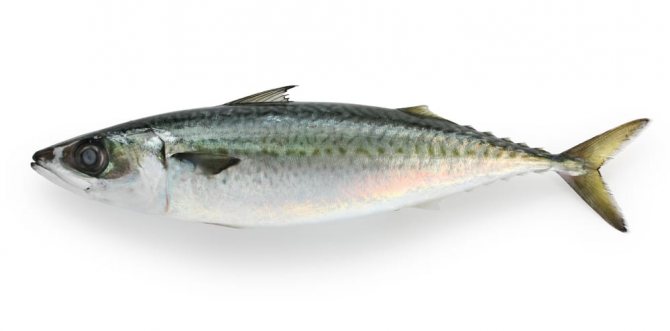
Mackerel meat is very useful, especially for people who have problems with the heart and blood vessels, seizures, nervous disorders, and rickets. Protein, which is largely found in the meat of this fish, is absorbed almost instantly and delays the aging of the body. Eating mackerel also improves immunity, reduces the risk of diabetes and improves hormone function.
Important! People who have elevated selenium levels and problems with the gastrointestinal tract should not consume this fish.
Mackerel is a real storehouse of Omega-3, improves blood circulation and memory, saturates the body with B vitamins, for women it reduces the risk of breast cancer, rejuvenates skin and hair. Has an antioxidant effect on the body. But no matter how healthy mackerel and mackerel are, everything good should be in moderation, otherwise it will lead to negative consequences. It is especially harmful to consume it in large quantities for people with hypertension, kidney, liver and gastrointestinal diseases.
Features of character and lifestyle

Photo: Sea mackerel
Active during the daytime and at dusk, resting at night. When hunting other fish, they make a sudden attack, most often from an ambush. During such short throws they can reach very high speeds, making it very difficult to escape them.
The fish is pelagic, that is, it usually lives at shallow depths. It lives in schools, sometimes mixed: in addition to the mackerels themselves, it may include sardines and some other fish. They tend to hunt both in packs and alone. When hunting together, schools of small fish often rise to the surface, where mackerel continue to chase them.
As a result, other aquatic predators, interested in what is happening, and birds, primarily seagulls, come into play - this is how some mackerels turn from hunters into prey, because they lose their vigilance when they try to catch other fish.
But all this applies to the warm period of the year. For several winter months, mackerel completely changes its lifestyle and goes into a kind of hibernation. Although this cannot be called full-fledged hibernation, the fish gather in wintering pits in large groups and remain motionless for a long time - and therefore do not eat anything.
Mackerel lives for quite a long time - 15-18 years, sometimes 22-23 years. It grows more and more slowly with age, the best age for catching is considered to be 10-12 years - by this time it reaches a fairly large size, and the meat becomes the most delicious.
Social structure and reproduction

Photo: Mackerel
Mackerel live in schools, either of fish of the same species or mixed, most often with herring, which is why they are usually caught together. Schools contain fish of the same size; very rarely they contain both large fish 10-15 years old and very young ones. It spawns from the second year, after which it does so annually. The first to spawn are the oldest mackerel, having reached 10-15 years of age; in the Atlantic population this occurs in April. Then, gradually, younger and younger individuals go to spawn, and so on until the last weeks of June, when fish at the age of 1-2 years spawn.
Thanks to annual reproduction and a large amount of eggs laid at a time (approximately 500,000 eggs per individual), mackerel breeds very quickly, and even despite a large number of threats and industrial fishing there is a lot of it. To spawn, the fish goes to warm waters near the shore, but at the same time chooses a place deeper and lays eggs at a depth of 150-200 m. This provides protection from many egg eaters, including other fish that do not swim so deep.
The eggs are small, about a millimeter in diameter, but in each, in addition to the embryo, there is also a drop of fat, which it can feed on at first. After the mackerel spawns, it swims away, but the eggs need to lie for 10-20 days for the larva to form. The exact period depends on the parameters of the water, primarily its temperature, which is why mackerel tries to choose a warmer place for spawning.
The newly born larva is both defenseless against predators and very aggressive itself. She attacks everything that is smaller and seems weaker, and devours prey if she manages to defeat it - her appetite is simply extraordinary. They also eat their own kind. When emerging, the larva is only 3 mm in length, but, actively feeding, it begins to grow very quickly. Since there is not enough food for everyone, most of them die during this period, but the rest grow to 4-5 cm by autumn - however, they still remain quite small and defenseless.
After this, the period of most active growth passes, the fish become less bloodthirsty, and their behavior begins to more and more resemble adults. But even when mackerel become sexually mature, their size is still small and they continue to grow.
Natural enemies of mackerels

Photo: What mackerel looks like
Many predatory fish and other marine animals prey on mackerel.
Among them:
- sharks;
- dolphins;
- tuna;
- pelicans;
- sea lions.
Despite the fact that it swims quickly, it is difficult for it to escape from such large predators simply because of the difference in size. Therefore, when such large fish attack, the school can only rush in different directions. In this case, each individual can only count on the fact that the predator will not go in pursuit of it.
At the same time, the predators themselves can attack in groups at once, and then the school of mackerel suffers very much; in one such attack it can be reduced by a quarter. But in mixed schools, other fish are usually at greater risk, because mackerel are faster and more maneuverable.
When the fish finds itself at the very surface of the water, it begins to be threatened by attacks from large birds and marine mammals. Sea lions and pelicans especially love it. Even when they are full of other prey, they often wait for mackerel, because its fatty meat is a delicacy for them.
Interesting fact: When buying frozen mackerel, it is important to pay attention to several signs that can help you understand that it was stored correctly and is not expired. The mackerel should be shiny and elastic, without wrinkled areas on the skin - this indicates that it has not been defrosted previously.
The meat should be creamy in color. If it is too pale or yellowish, the fish was caught too long ago or was defrosted during storage or transportation. A large amount of ice indicates improper storage, so the meat will most likely turn out to be loose.
Chemical composition, calorie content
Eating 100 grams of mackerel provides a person with the daily requirement of omega-3 fatty acids. The chemical composition of fish also contains saturated and monounsaturated fatty acids and amino acids, for example:
- stearic;
- myristic;
- oleic;
- linoleic;
- alanine;
- arginine;
- histidine;
- lysine;
- methionine;
- phenylalanine;
- tyrosine
Amount of vitamins in 100 grams of mackerel:
- A - 10 mcg;
- B1 - 0.12 mg;
- B2 - 0.36 mg;
- B4 - 65 mg;
- B5 - 0.85 mg;
- B6 - 0.8 mg;
- B9 - 9 mcg;
- B12 - 12 mcg;
- C - 1.2 mg;
- D - 16 μg;
- E - 1.6 mg
- H - 0.18 μg;
- K - 5 mcg;
- RR - 11.6 mg.
Saturation of 100 grams of fish with macro and microelements:
- potassium - 280 mg;
- phosphorus - 280 mg;
- sulfur - 180 mg;
- chlorine - 170 mg;
- sodium - 100 mg;
- magnesium - 50 mg;
- calcium - 40 mg;
- iron - 1.7 mg;
- fluorine - 1.4 mg;
- zinc - 0.7 mg;
- manganese - 0.1 mg;
- copper - 210 mcg;
- iodine - 150 mcg;
- chromium - 55 mcg;
- selenium - 44 mcg;
- cobalt - 20 mcg;
- nickel - 6 mcg;
- molybdenum - 4 mcg.
KBZHU 100 grams of fish depends on the time of catch. In autumn and winter it can contain up to 28% fat, and immediately after spawning in spring and summer this figure drops to 13%. Protein in 100 grams of fish is 18–19 grams, no carbohydrates. The calorie content of raw mackerel ranges from 190 to 262 kcal.
The nutritional energy value depending on the cooking methods is shown in the table.
| Type of fish | Kcal per 100 grams |
| Boiled | 209 |
| For a couple | 191–196 |
| Stewed | 189 |
| Baked in the oven | 191 |
| Fried in oil | 221–278 |
| Grilled or grilled | 178–203 |
| Hot smoked | 317 |
| Cold smoked | 222–290 |
| Salty | 194 |
| lightly salted | 181 |
| Canned in oil | 319 |
| Canned in tomato | 200 |
| Pickled | 135 |
Differences from other fish
Fish on the menu is often replaced with other types of seafood. However, when using them, it should be taken into account that each of them has its own characteristics. Examples:
- King mackerel. Refers to low-fat fish. Contains more vitamin A, potassium and iron. It has a better effect on vision and helps get rid of anemia and kidney problems faster. Inferior in the amount of vitamins D and group B, omega acids, iodine, fluorine.
- Tuna. Contains fewer calories but more protein. It surpasses mackerel in the amount of iodine, but lags behind in the concentration of macroelements and vitamins.
- Saira. Less saturated with iron, fluorine, calcium. Inferior in usefulness for anemia, brittle bones, heart disease.
- Horse mackerel. Contains 2 times less calories. It has a lower concentration of vitamin D, iodine, selenium, but more calcium and zinc.
- Sardine. Less calorie. It helps better with anemia, as it is superior in the amount of iron. It is more saturated with calcium and zinc, but is inferior in the concentration of iodine, manganese, and fluorine.
- Herring. Contains less fat, micro and macroelements, vitamins. It is ahead of mackerel only in the amount of calcium and zinc, therefore it is less useful.
- Pink salmon. The main difference is that it refers to fish with red meat. More saturated with potassium, iodine, vitamin B1, manganese, protein. It lags significantly behind in the concentration of fluoride, calcium, and vitamin D, and is therefore less effective for osteoporosis.

King mackerel

Tuna

Saira

Horse mackerel

Sardine

Herring

Pink salmon


